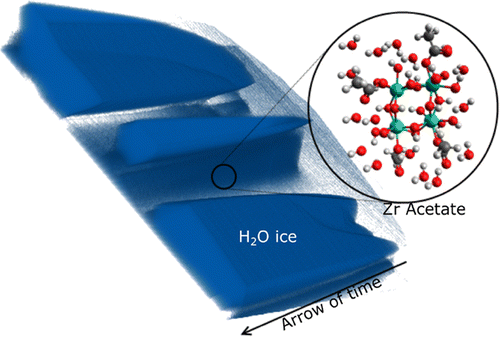Watching water freeze

Every winter, snow and ice dusts mountains and makes roads slick in cold climates. This phenomenon is ages old, but a detailed explanation for how ice crystals form has eluded us. In a study appearing in the journal ACS Omega, scientists now report a method to visualize ice in three dimensions as it grows. This knowledge could have a range of potential uses in materials science, geophysics, biology and food engineering.
What scientists know for sure is that ice shape and size depend on a number of factors, such as pH, the speed at which the temperature drops and the composition of additives. They have tried controlling ice shape by adding a variety of compounds, including sugar, ethanol and naturally occurring anti-freeze proteins from fishes, plants and insects. But to gain a deeper understanding of how ice forms—and potentially to have better control over the process—scientists have been working on new ways to watch crystals grow in real time. Several methods have been attempted, but none have provided reliable 3-D visualizations. A team of scientists from the Ceramics Synthesis and Functionalization Lab in France took a different approach.
The researchers demonstrated that confocal laser scanning microscopy and image analysis can rapidly capture a series of pictures showing the ice crystals growing. The images can then be used to measure how fast the crystals expand and lengthen. The approach has promise for further studying ice growth under varying conditions and with the addition of polymers, proteins or other compounds, the researchers say.
More information: Moreno Marcellini et al. Time-Lapse, in Situ Imaging of Ice Crystal Growth Using Confocal Microscopy, ACS Omega (2016). DOI: 10.1021/acsomega.6b00217
Abstract
Ice crystals nucleate and grow when a water solution is cooled below its freezing point. The growth velocities and morphologies of the ice crystals depend on many parameters, such as the temperature of ice growth, the melting temperature, and the interactions of solutes with the growing crystals. Three types of morphologies may appear: dendritic, cellular (or fingerlike), or the faceted equilibrium form. Understanding and controlling which type of morphology is formed is essential in several domains, from biology to geophysics and materials science. Obtaining, in situ, three dimensional observations without introducing artifacts due to the experimental technique is nevertheless challenging. Here we show how we can use laser scanning confocal microscopy to follow in real-time the growth of smoothed and faceted ice crystals in zirconium acetate solutions. Both qualitative and quantitative observations can be made. In particular, we can precisely measure the lateral growth velocity of the crystals, a measure otherwise difficult to obtain. Such observations should help us understand the influence of the parameters that control the growth of ice crystals in various systems.
Provided by American Chemical Society




















